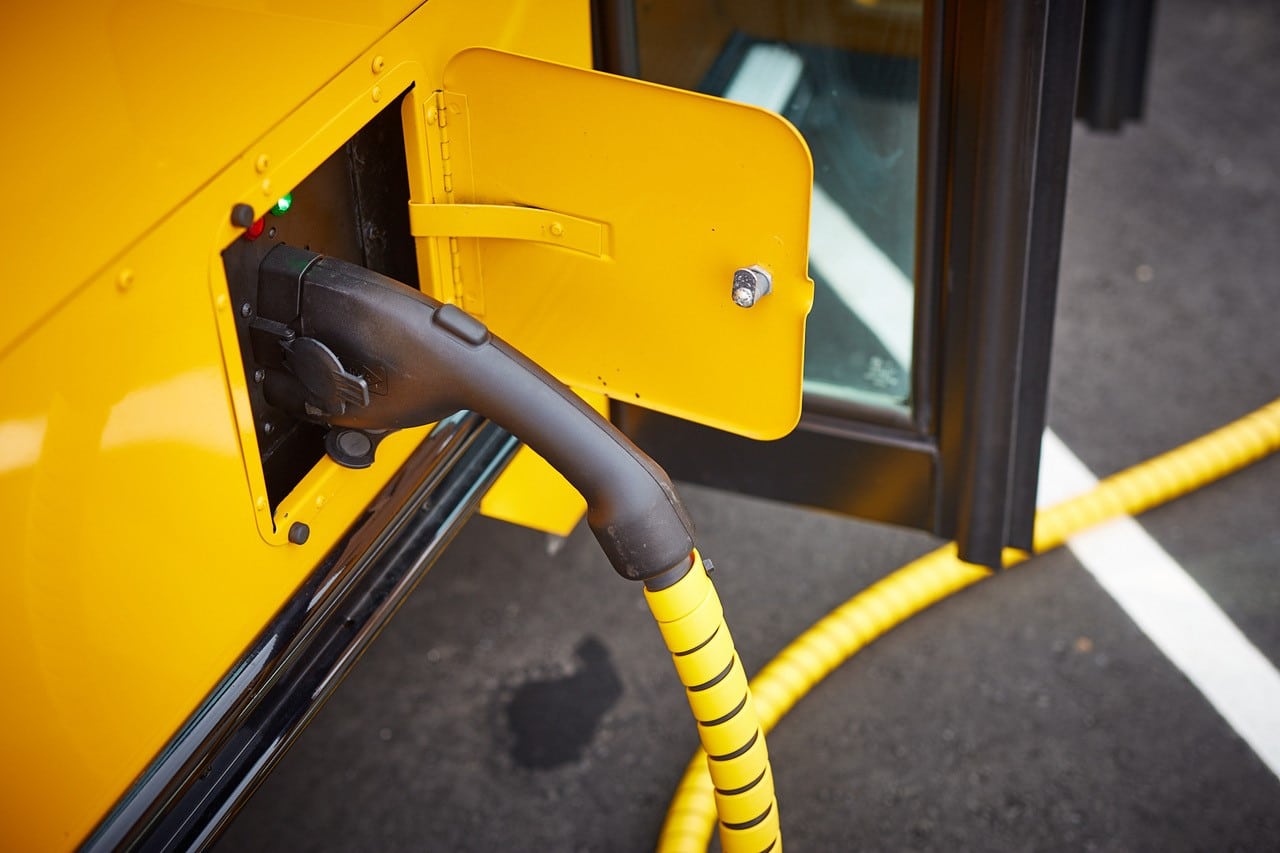
Electric buses can be a great way to care for your students, their communities, and our environment, but it is far more complicated than just buying a bus and plugging it into the wall. It involves a multitude of steps and stakeholders.
School districts that are thinking about adding electric school buses to their fleets need to understand the total cost of ownership (TCO). Some of the costs that comprise TCO vary by location, so it is imperative to understand the impact of local factors, such as geography, climate, and terrain on costs, which include:
- Cost of Bus/Fuel/Electricity
- Battery Considerations
- Charger Selection
- Managed vs. Unmanaged Charging
- Infrastructure Design and Installation
- Operational Layout
- Maintenance and Safety
- Designing for Future Deployments
Cost of Bus/Fuel/Electricity
An electric school bus is considerably more expensive than a diesel bus, but the initial price can be brought down in some ways, including:
- Federal, state, local and private grants and funding
- Local utilities’ investments
- Settlement funds like the Volkswagen ZEV Investment Plan
- Leverage a partner with purchasing scale to get the best price
Electric school buses come with the potential to provide future cost savings and revenue. Potential cost savings can come through lower maintenance costs and cheaper, more stable electric (e.g., “fuel” prices. In some cases, potential revenue or reduction of energy use comes from V2G (Vehicle to Grid) revenue where you can buy energy during non-peak hours and sell it back to the grid during peak hours.
Future cost savings and revenue are great, but they do nothing to bring down the initial price of and electric bus, which can be cost prohibitive. Working with a partner like First Student can help you realize those future revenue and savings now as well having an experienced team as your partner to implement all of the issues around electrification.
We will assess your district’s circumstances and underwrite the future revenue and savings from adding electric vehicles to your fleet. This allows your district to realize future saving and revenue now and bring down the cost of electric buses to close to the price of a diesel bus.
Battery Considerations
An electric school bus battery is a key driver of TCO because, on average the battery makes up 30%-50% of the cost of the bus. In addition to the upfront cost, your battery strategy can have a major impact on operations, costs and revenues.
Because batteries are so important, special consideration needs to be given to the battery size and chemistry your district chooses and all the options that go along with it including capacity & range, degradation and replacement timing, warranties and leasing options.
One of the first considerations is the battery’s capacity and range (or size in kWh). Some key questions that need to be answered are: how long will your bus run and how many miles will it need to travel? And, when not in use, how long does the bus have to charge?
The second consideration is battery degradation and replacement. Currently, the estimated life for an electric school bus battery is 6 – 10 years, but there are scenarios that contribute to the batteries state of health (SOH) that could drive battery degradation speed and replacement timing.
State of Health is a measurement that reflects the condition of a battery or battery pack, and its ability to deliver the specified performance compared with a brand-new battery.
SOH is reported in percentage points where 100% indicates that the battery’s current condition matches the battery specs. SOH degrades over time and factors that affect it besides normal usage include climate, charger type and charger speed.
A third factor to consider when selecting are battery warranties. It is critical to understand the details of your battery warranty and keep track of the KPI’s required to prove that you respected the warranty and provide protection when an issue arises. Some of the important KPI’s include:
- Energy Used
- Charge Cycles
- Average State of Charge (SOC)
- Depth of Discharge (DOD)
- Cell Temperatures
- Current Rate
With so many options, it is essential to work with a partner who can help determine the battery strategy that is in your districts best interest to reduce initial cost, but also takes into consideration total cost of ownership, especially because battery decisions can have a major impact on infrastructure.
Charger Selection
Electric school buses are charged by electric vehicle supply equipment (EVSE), using either alternate current level 2 (AC) or direct current fast charge (DCFC) systems. AC systems are less expensive, but they charge the buses more slowly. DCFC charging systems charge electric buses more quickly but cost more upfront.
Selecting the type of charger involves more than just weighing the costs vs the benefits, because the type of charger effects the buses availability to meet route requirements and the battery’s longevity but could also help you realize cost savings through managed charging.
Managed Charging vs. Unmanaged Charging
Managed charging software allows districts to plug in a bus, and have the bus only charge when, and if needed. The chargers can also be programmed to charge the school bus during the least expensive times of day. This new managed charging infrastructure helps to reduce standby power and decrease the total cost of energy.
Unmanaged charging infrastructures aren’t programmed to avoid charging during peak times, in turn, costing districts more.
Infrastructure Design and Installation
Infrastructure requires more than just deciding where to plug your bus in or where to install a charger. In many cases the whole operation must be redesigned to accommodate the needed infrastructure. All this infrastructure requires proper planning and has a direct effect on the cost and the time it takes before your electric school buses can start running routes.
Infrastructure requirements are substantial and extend beyond the bus and the charger, in some cases all the way to the utility asset or generator. It is critical to understand your site’s electrical capacity, and where you are in relation to the electric supply you need to power your operation. Depending upon your electrical capacity, and where you are in the country, it could take more than a year to install the required electrical system upgrades.
All of this infrastructure comes with a price tag. On average one electric bus can require $10K-$30K in additional infrastructure. Not only is it expensive, but it can have an impact on your operational layout.
Operational Layout
When electrifying your fleet, it is critical to look at your operational layout because you have to be strategic about where you install charging station. Most charging infrastructure requires access to 3-phase power (supplies power at a more efficient, steady, constant rate), so installing the charger close to a building can help to reduce costs.
There may be parking lots that are not able to accommodate some types of charging infrastructure without expensive utility upgrades. Exploring your charging needs and options up front will help determine the type and/or number of buses and chargers that will work best for your district.
First Student has experience with fleet management and operations and EV infrastructure design, engineering, and architecture. We can help you weigh all of your infrastructure options, including determining if additional real estate and/or an operational re-design is necessary.
Maintenance and Safety
While electric buses require less maintenance because they have fewer moving parts, technicians will still need to be trained in how to safely service electric buses. Maintenance technicians will also require training on electric engines and subsystems, including cooling, HVAC, air compressors and power steering.
In addition to training just the staff that will be driving and maintaining your electric fleet, additional expense will be brought about from:
- Site wide safety training for electricity and vehicle charging
- Fire suppression systems because of increased risk of electricity fire
- Maintaining electric and diesel parts inventory
- Tooling required for electric bus maintenance
Designing for Future Deployments
Finally, when examining all the factors above, you need to look beyond the initial deployment of electric school buses. Your first order could be 3 to 10 buses, but you have 50 or 100+ in the fleet. Working with your utility from the outset on your future plans can be critical. The utility may be able to bring electrical service to your site to contend with future bus purchases. This can have substantial cost implications. Understanding how to speak with your utility on this matter and understanding the incentives and programs utilities offer can lead to an installation that covers your growth for years to come and not disrupt operations in the future.
Further, future proofing your location can assist you in taking advantage of V2G energy markets that develop in the future or change to provide additional benefits.
Bringing Down the Total Cost of Ownership
Cost and complexity are the two biggest barriers a district faces when looking to add electric school buses to their fleet. First Student is here to help. We offer a turnkey solution to districts, partnering with you at every step to reduce the complexity and remove the cost barriers to fleet electrification. Visit us at www.firststudentinc.com/EV, or email us at electrification@firststudentinc.com to learn more about how First Student can help your district electrify your fleet.
About the Author

Kevin Matthews is the Head of Electrification at First Student and is responsible for the strategy that will drive the development and deployment of all electrification initiatives and technologies. Kevin has worked in the environment sector for more than 30 years. He has served as the managing director of the sustainability sector at National Strategies, LLC, as well as served as the co-project director of the Clinton Global Initiative EV School Bus project, which set out to retrofit school buses to zero emission. Kevin worked at AIG Environmental and took on several different roles in the U.S. Environmental Protection Agency.